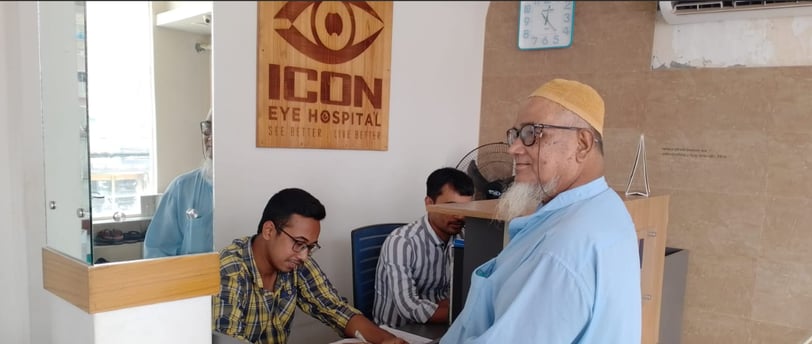Clear Vision, Bright Future: The Eye Care Landscape of Bangladesh
Icon Aid Foundation Desk
9/20/20232 min read


The eyes are often referred to as the windows to the soul, but for many in Bangladesh, clear vision is a luxury they don't have access to. The eye care landscape in Bangladesh has seen significant progress over the years, yet challenges persist. In this blog post, we'll take a closer look at the state of eye care in Bangladesh, exploring its achievements, challenges, and the path toward a brighter future.
The Vision Challenge:
Bangladesh, like many low- and middle-income countries, faces numerous eye care challenges:
High Prevalence of Vision Impairment: A substantial portion of the population suffers from vision impairment due to various factors, including cataracts, refractive errors, and glaucoma.
Limited Access to Eye Care Services: Many people in rural areas have limited access to eye care facilities, with eye specialists concentrated in urban centers.
Financial Barriers: The cost of eye care services and treatment can be a significant barrier, preventing those in need from seeking help.
Lack of Awareness: A lack of awareness about eye health and the importance of regular eye check-ups contributes to delayed diagnoses and treatment.
Progress Made:
Despite these challenges, Bangladesh has made commendable progress in the field of eye care:
Community-Based Eye Care: Initiatives like the Community Eye Care (CEC) program have extended eye care services to remote areas, offering screenings and basic treatment.
Vision Centers: The establishment of vision centers across the country has improved access to primary eye care services.
Skilled Workforce: Bangladesh has a skilled workforce of ophthalmologists, optometrists, and eye care professionals who work diligently to provide quality care.
Public and Private Partnerships: Collaboration between the government, NGOs, and private eye care facilities has expanded the reach of eye care services.
The Path Forward:
To further enhance the eye care landscape in Bangladesh, several steps can be taken:
Increase Awareness: Launch nationwide campaigns to raise awareness about the importance of regular eye check-ups and the availability of affordable eye care services.
Strengthen Primary Care: Focus on strengthening primary eye care services at the community level, including the training of community health workers.
Telemedicine: Explore telemedicine and mobile health solutions to reach remote areas with limited access to eye care facilities.
Affordable Treatment: Implement cost-effective measures to reduce the financial burden of eye care, such as subsidized surgeries and eyeglasses.
Research and Innovation: Invest in research and innovation to develop new treatments, improve surgical techniques, and enhance the quality of eye care.
Government Support: Encourage government support for eye care initiatives and policies that prioritize eye health.
Conclusion: A Vision for a Brighter Future
The eye care landscape in Bangladesh is on a promising trajectory, with numerous initiatives and dedicated professionals working tirelessly to improve the vision of the nation. However, there is still work to be done to ensure that every citizen, regardless of their location or financial status, has access to quality eye care services. By increasing awareness, expanding access, and embracing innovation, Bangladesh can look forward to a future where clear vision is a reality for all, leading to improved quality of life and socio-economic development. The journey to a brighter future begins with a clear vision for comprehensive eye care.

